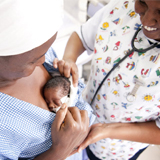
Objective: Compared with in utero transport, incubator transport for preterm infants has several disadvantages including instability during transport with increased mortality and morbidity, lack of adequate systems for securing the infant in the event of an accident, and separation of mother and infant. As a new kind of postnatal transportation that bears some analogy to in utero transport and may be safer than incubator transport, we investigated kangaroo transport, transporting the infant on the mother’s or other caregiver’s chest. This article presents a description and preliminary data for kangaroo transport.
Design: We conducted kangaroo transports of 31 stable preterm and term infants in different settings and recorded data regarding transport conditions and cardiorespiratory
Results: Heart rate, respiratory rate, oxygen saturation, and rectal temperature remained stable during all kangaroo transports lasting 10 to 300 minutes. Weight at transport was 1220 to 3720 g. Parents felt very comfortable and safe and appreciated this method of transport.
Conclusions: Kangaroo transport promotes mother-infant closeness and might ameliorate several of the risks associated with incubator transport.